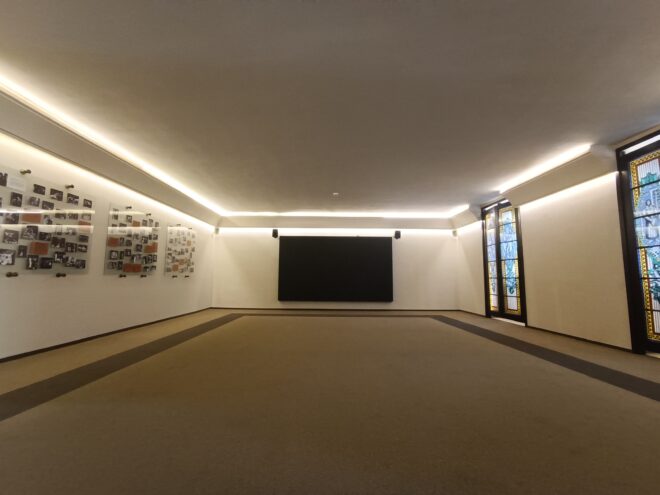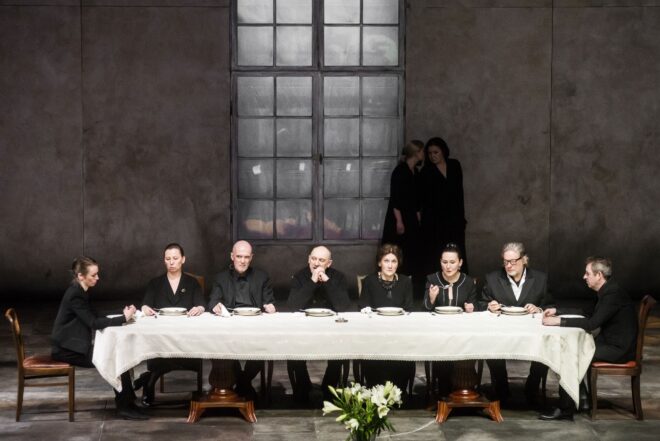by Aušra Kaminskaitė. Publication Series on Lithuanian Theatre in Cooperation with Menufaktura.lt
For centuries, theatre was known as great entertainment. People went to have fun, to catch up on gossip, to be seen, and, of course, to experience deep emotions while sitting safely in the stalls.
However, over the last century, theatre creators have been building a totally different approach to this art form. With the appeareance and development of the figure of the director, theatre was recognised as an intellectual activity, and is nowadays occasionally considered an art form aimed at an elite audience. This is an obvious but often forgotten fact when discussing the value of dramatic art.
The question is at the centre of a situation that is barely ever mentioned in the Lithuanian media: there is a clear difference in content between two important Lithuanian state theatres, the Lithuanian National Drama Theatre (LNDT) and the State Youth Theatre (SYT). With the 2022-2023 season, it became obvious that the LNDT is heading towards audience-friendly art, whereas the SYT is putting all its efforts into presenting and representing intellectual theatre, to which the audience comes to think, that is, to work.

Lithuanian National Drama Theatre. Photo by Dmitrijus Matvejevas
More than a decade ago, both theatres had average repertoires, with a lot of ‘commercial’ comedies, and hardly any ambitious productions. The theatre community reacted differently to them. There were a lot of discussions about the LNDT in the media: students even organised a protest at which they ate popcorn at the main entrance to the theatre. As for the SYT, almost nothing was said or done in public, although privately the arts world laughed at its repertoire.

State Youth Theatre. Photo by Andrius Jevsejevas
Both theatres made a significant change in their repertoires when the critic and producer Audronis Liuga took over. In 2010 he became artistic director of the LNDT, and Martynas Budraitis became director general. The repertoire changed drastically: the popular ‘commercial’ shows were moved to a private comedy theatre, quite a few productions were suspended, famous Lithuanian and even foreign directors were invited, and new actors were taken on.
When his first term as director general ended, Budraitis reapplied. This time, the position of artistic director was not treated separately, which made him responsible for the repertoire too. More changes were made: there was more room for experimentation, audiences noticed the lack of classic productions, and famous Lithuanian directors were still putting on shows, but in general the repertoire continued with those that had been staged during Budraitis’ first term when he used to work with Liuga.
Later, like everybody else, the LNDT experienced the consequences of lockdown; furthermore, the theatre’s refurbishment started, which is expected to end in the autumn of 2024. Nevertheless, there are some noticeable tendencies in the best-funded drama theatre in Lithuania. Firstly, it developed lasting contacts with foreign artists, such as Jo Strømgren, Łukasz Twarkowski and Anna Smolar. Secondly, it became actively involved in addressing social issues: it supported Ukraine, it presented itself as LGBTQ+ friendly, and it became more open to women creators (two out of the three current LNDT artistic directors are women). Finally, the theatre developed an audience-friendly repertoire.
The best evidence of this change is the growing status of Antanas Obcarskas, who now belongs to a trio of artistic directors (along with Kamilė Gudmonaitė and Eglė Švedkauskaitė). Having started at the LNDT as a manager, he eventually became an unofficial permanent director, adding a show almost annually to the LNDT’s repertoire. Although he learned directing from famous practitioners, such as Gintaras Varnas, Yana Ross, and the late Eimuntas Nekrošius, his artistic style is exceptional, even in the context of young Lithuanian directors. Together with his creative team, Obcarskas tackles many philosophical and cultural issues, and combines them with the need to please the audience and preserve the entertainment role of the theatre. This may sound like perfect harmony; however, these criteria rarely merge in his shows, and are usually noticeable in different parts of a production.
Most of the LNDT’s premières in the 2022-2023 season tend to attract audiences rather than setting a standard for artistic value. One show (directed by Paulius Tamolė) was based on George Orwell’s Animal Farm, and despite its low quality, it was quite well attended (probably because of the literary connection). Another première was staged by Ivan Vyrypaev, based on his famous play The Drunks. The staging literally followed the play: it was a presentation of a set of situations where drunkards met their family, friends and strangers. Since the play has several comic episodes, and several of the best Lithuanian actors are in it, it has been sold out.
These are a few of the latest examples of the LNDT’s current direction. Of course, the repertoire still includes works by Lithuanians. Some of them are staging new shows for the 2023-2024 season. Some of the older productions will be brought back after the end of the refurbishment. For example, the famous Expulsion (by Marius Ivaškevičius, directed by Oskaras Koršunovas) will be put on in January 2024, unlike, for example, Heroes’ Square (directed by Krystian Lupa), which was one of the most artistic shows at the theatre before the pandemic and the refurbishment started.

„Heroes’ Square”, directed by Krystian Lupa (Lithuanian National Drama Theatre, 2015). Photo by Dmitrijus Matvejevas
Heroes’ Square (like Expulsion) is one of the shows that was staged during Budraitis’ first term when Liuga was in charge of the repertoire. Later, in 2016, Liuga became head of the SYT, and started building up a repertoire with more or less the same directors he had worked with during his new beginning at the LNDT: Krystian Lupa, Árpád Schilling, Kirsten Dehlholm, Eimuntas Nekrošius, Gintaras Varnas and Yana Ross. There is clearly no doubt about the expertise these people bring to the stage, and their style is well known all over Europe (and in some cases even beyond). Liuga even persuaded the film director Sergei Loznica to put on a theatre production for the first time in his life. Thus, the SYT has become a good example of high-quality theatre: it has full-length shows staged by internationally recognized directors, it explores current serious topics (such as the legacy of the Holocaust, or the search for one’s true identity), it employs some of the best Lithuanian actors, and it creates a home for young directors whose creative style resembles that of Nekrošius.

„Erinyes”, directed by Sergei Loznica (State Youth Theatre, 2022). Photo by Laura Vansevičienė
The SYT’s marketing also aims to have the institution recognised as a place for intellectual entertainment, and even as a place for intellectual expression and meetings. This is quite a different path to the one currently taken by the LNDT, and it might sound like the path that a national theatre should actually take: to set an example of high-class theatre.
But let us go back to what we said at the beginning. For centuries, theatre was known as great entertainment. I am not trying to say that it is supposed to cheer up the audience. However, I think that when evaluating state theatres, we also have to bear in mind the attendance figures, because the state consists of people, and if they do not go to see creative work, the state theatre is not doing its job. Unfortunately, all the long, serious and intellectual shows at the SYT attract fewer people than most of the more entertaining shows at the LNDT. We could say that, in general, the SYT has not been a people-friendly institution since the administrative staff changed after Liuga took over. The LNDT, on the contrary, has quite a solid team formed by Budraitis.
In comparing these theatres, it is important to note that they are funded differently, since they both have a different status, which is expressed by their names (National and State). The LNDT is housed in a big building on the main street in the centre of Vilnius, and employs more people, both on the creative side and other personnel, than any other theatre in Lithuania. The SYT is located in a more obscure part of Vilnius’ Old Town, and employs fewer people, although more than most other Lithuanian state drama theatres.
This article has been written exclusively for a foreign audience, to help them understand what they can expect from theatres they are planning to visit. And since both institutions tend to put on very long productions (from two to six hours), it might be impossible to visit both of them; therefore, it is useful to have some guidance in advance. Most importantly, this comparison of the LNDT and the SYT shows perfectly the variety in Lithuanian theatre, and it illustrates the need to have several different theatres, since none of them can meet everyone’s expectations.
—–
Publikaciją finansuoja Lietuvos kultūros taryba
